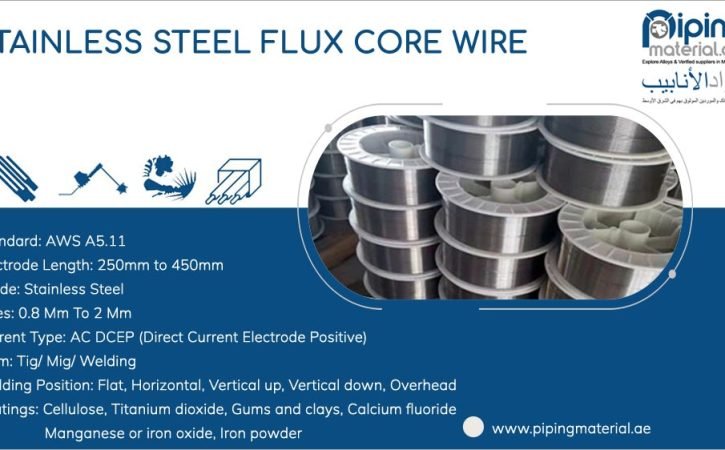Introduction:
Welding is a fundamental process in the world of metalworking, allowing for the joining of different materials. Two widely used welding consumables are titanium welding rod and stainless steel flux core wires. In this blog post, we will explore these two essential welding materials, their characteristics, applications, and considerations for successful welding.
Understanding Titanium Welding Rods:
Titanium welding rods are specifically designed for welding titanium and its alloys. Titanium, known for its exceptional strength-to-weight ratio, corrosion resistance, and high melting point, requires specialized welding techniques and materials. Titanium welding rods are made from pure titanium or titanium alloy and are available in different grades to suit various applications.
Key Characteristics of Titanium Welding Rods:
- Low thermal conductivity: Titanium has low thermal conductivity, meaning it absorbs less heat compared to other metals. This characteristic requires precise control of heat input during welding to prevent distortion or damage to the material.
- High reactivity: Titanium readily reacts with oxygen, nitrogen, and other atmospheric gases at elevated temperatures. It is essential to protect the weld zone from contamination by using an inert gas shield, such as argon, during the welding process.
Applications of Titanium Welding Rods:
Titanium welding rods find applications in various industries, including aerospace, automotive, marine, medical, and chemical processing. Some common applications include:
- Aerospace components: Titanium’s high strength, lightweight, and excellent corrosion resistance make it ideal for aircraft parts, such as engine components, landing gear, and structural elements.
- Medical implants: Titanium is biocompatible, making it suitable for medical implants like joint replacements, dental implants, and bone fixation devices.
Tips for Titanium Welding:
- Cleanliness is crucial: Titanium is highly sensitive to contamination, so it’s essential to ensure the welding area, filler material, and tools are clean and free from oil, grease, or other impurities.
- Precise heat control: Due to titanium’s low thermal conductivity, controlling the heat input is crucial to prevent distortion or overheating. Use pulse or low-amperage welding techniques and minimize the number of weld passes.
- Argon shielding gas: Protect the weld zone with an argon gas shield to prevent oxygen, nitrogen, and moisture from contaminating the weld.
Understanding Stainless Steel Flux Core Wire:
Stainless steel flux core wire is a type of welding consumable used for welding stainless steel. It consists of a Stainless steel flux core wires heath filled with flux, which releases a shielding gas during the welding process, protecting the molten weld pool from atmospheric contamination. Flux core wire eliminates the need for an external shielding gas, making it convenient for outdoor or windy conditions.
Key Characteristics of Stainless Steel Flux Core Wire:
- Self-shielding: Stainless steel flux core wire is classified as self-shielded, as it generates a shielding gas when the flux inside the wire melts. This property allows for welding in environments where external gas shielding may be difficult.
- High deposition rates: Flux core wire enables high deposition rates, making it suitable for applications where productivity is crucial.
Applications of Stainless Steel Flux Core Wire:
Stainless steel flux core wire finds applications in various industries, including construction, automotive, food processing, and petrochemicals. Some common applications include:
- Structural fabrication: Flux core welding is widely used in structural fabrication, such as welding beams, columns, and frames made from stainless steel.
- Repair and maintenance: Flux core wire is convenient for on-site repairs and maintenance tasks, as it eliminates the need for an external shielding gas.
Tips for Stainless Steel Flux Core Welding:
- Choose the right wire: Stainless steel flux core wires are available in different grades and sizes. Select the appropriate wire that matches the base metal and desired weld characteristics.
- Adequate ventilation: While flux core wire eliminates the need for external shielding gas, it produces more fumes compared to solid wire welding. Ensure proper ventilation and use personal protective equipment (PPE) to protect against fume exposure.
- Joint preparation: As with any welding process, proper joint preparation is crucial. Clean the joint surfaces, remove any contaminants, and ensure proper fit-up for successful welds.
Conclusion:
Titanium welding rods and stainless steel flux core wires are valuable consumables in the welding industry. Titanium rods enable the welding of titanium and its alloys, offering high strength and corrosion resistance. Stainless steel flux core wires provide a self-shielded solution for welding stainless steel, with high deposition rates and convenience in outdoor conditions. By understanding their characteristics, applications, and following essential welding tips, you can achieve successful welds using these consumables. Always refer to the manufacturer’s guidelines and consult with welding professionals for specific welding requirements and recommendations.










